| کد مقاله | کد نشریه | سال انتشار | مقاله انگلیسی | نسخه تمام متن |
|---|---|---|---|---|
| 4414368 | 1307710 | 2008 | 7 صفحه PDF | دانلود رایگان |

The transport and bioavailability of sediment-associated contaminants are often controlled by the contaminants’ desorbing behaviour. This study examines the desorption kinetics of polychlorinated dibenzo-p-dioxins (PCDDs), dibenzofurans (PCDFs), diphenyl ethers (PCDEs) and hydroxydiphenyl ethers (HO-PCDEs) from the highly contaminated River Kymijoki sediment in Finland. The desorption kinetics data were generated using Tenax® extraction, and a first-order three-compartment kinetic model was fitted to the data. The desorption data was compared to the previously published accumulation data from this same location to investigate the relationship between the rapidly desorbing fraction (Fr) and biota-sediment accumulation factors (BSAFs) as well as semipermeable membrane device sediment accumulation factors (SSAFs).The PCDDs, PCDFs, PCDEs and HO-PCDEs were tightly attached to sediment particles and formed a large very slowly desorbing fraction (Fvs). Rapidly desorbing fractions (Fr) varied between 0.8% and 8% of total amount in sediment. The size of the desorbing fraction was congener-specific and Fr decreased with the increasing lipophilicity of congeners. The size of the Fr was unable to explain the small variation in the BSAFs of Lumbriculus variegatus but may help to explain the observed variation in the SSAFs. To our best knowledge, this study is the first effort to investigate the desorption of PCDDs, PCDFs, PCDEs and HO-PCDEs in field-contaminated sediments. The major finding that the very slow desorption of these chemicals will continue years, provides essential information for the modern risk assessment process.
Journal: Chemosphere - Volume 72, Issue 1, May 2008, Pages 1–7